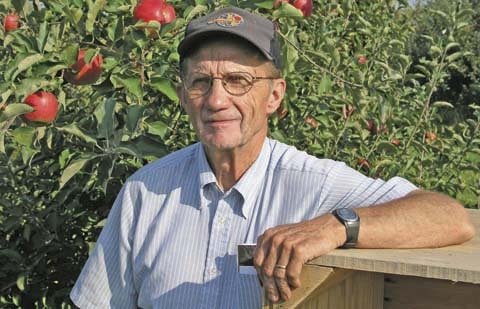
Wearing dual hats, George Lamont is involved with the family farm and also serves as executive director of the New York State Horticultural Society. (Photo by Melissa Hansen.)
Lamont Fruit Farms has focused on improving fruit quality since the mid-1980s, and they’re still working on it, says one of the partners of the family operation.
“It took longer to achieve than we thought it would. We’re still working on it,” said George Lamont, semiretired partner of the 580-acre farm comprised mainly of fresh-market apples. Included in the acreage mix are 20 acres of fresh-market cherries and peaches grown for local markets.
“To us, size is quality,” he said, explaining that quality goes back to many factors-soil structure and tilth, tillage, planting system, rootstocks, varieties, horticulture, cover crops, thinning, and pruning. “That’s why reaching quality has taken us so long.”
Lamont, a sixth-generation family farmer from Albion, New York, farms with his brother Roger and their partner Rod Farrow, production manager. At one time the family farm, which was established in 1815, produced processed tree fruit, cabbage, tomatoes, tart cherries, and other field crops. They no longer grow field crops, focusing now on apples grown for the wholesale fresh market.
The Lamonts and several other growers partnered together in 1982 to create Lake Ridge Fruit, Inc., a packing and cold storage operation in Albion. Lamont is one of the major suppliers of apples to the cold storage that is managed by Bill Gerling. Sales and marketing of Lamont’s crop is handled by New York Apple Sales.
Size
Their master plan is to produce the most profitable sized fruit, which today is the 88 count, George said.
In recent years, they have moved from growing trees in the vertical axis system to the higher-density super spindle, with around 2,000 trees per acre. They have grown their own trees for the last ten years as a way to reduce orchard establishment costs.
“We had to find a cheap way to do it,” George said, noting the sizable investment needed when planting a high-density orchard. They have also developed a systematic way of tiling new orchards for better drainage before planting.
Average rainfall in New York’s apple-producing regions is about 30 inches annually. Though most growers do not irrigate, some use trickle or drip irrigation on part of their land if water is available. In the past summer, very little rain fell until the end of August when the hurricane season brought rain.
The Lamonts have the ability to irrigate about half of their acreage, using it sometimes for new plantings.
Approximately 80 percent of their work force is brought in from Mexico under the H-2A program. The Lamonts work with grower groups in Tennessee and Kentucky to apply and comply with H-2A regulations.
Super spindle
Rod Farrow, originally from England, joined the Lamonts in 1986 after spending time on their orchard as part of an exchange program through Ohio State University. He noted that they gradually worked their way to higher densities, inspired by foreign trips taken with the International Fruit Tree Association.
“The whole idea is to get a return on your investment as fast as possible,” Farrow said.
When they increased tree density from 500 trees per acre to 2,000, orchard establishment costs became a big issue. By growing their own trees, Farrow estimated that they reduced tree costs by 40 percent, saving about $1,500 per acre.
“If you can’t grow your own trees, you can’t do the math,” he said, adding that they can grow trees cheaper than a nursery because they don’t have the same overhead costs.
Being your own nursery is not without risk, he warned. Most growers don’t grow their own stock because “you can have some major disasters and get pretty tripped up.”
The Lamonts use one-year-old bench-grafted trees, with Malling 9 as the rootstock. Farrow added that they want everything to grow in the nursery for one year to avoid the need to fill in gaps of lost trees.
“You can stay in business if you are producing apples pretty cheaply,” he said. “But if you’re striving for quality, you’re going to spend a lot of money.”
Tough years
Farrow acknowledged that the last ten years have been “fairly tough” for apple growers, with few young growers attending industry meetings. However, he is optimistic that profitability will return and the next generation of farmers will be involved in the industry.
“The key is who can produce an apple that’s wanted at a cost that’s profitable. To stay profitable, you have to increase volume and become more efficient.”
Fresh-sliced apples have been a positive development for New York producers, boosting the market for smaller-sized Empire apples, he added. Often, the best size for fresh-cut apples is 100-count or smaller.
Farrow believes that Lamont, as an individual orchard, is competitive with larger producers in Washington State because it isn’t spending the same level of capital in the orchard. Orchard inputs are not as high on the East Coast as in the West. They also have an advantage of being located within several hours of much of the nation’s population.
“We can compete as an individual orchard, especially when we have yields of 2,000 bushels per acre. When you get down to production costs per bushel, we’re in the ballpark-and we don’t have to truck it.”

Leave A Comment